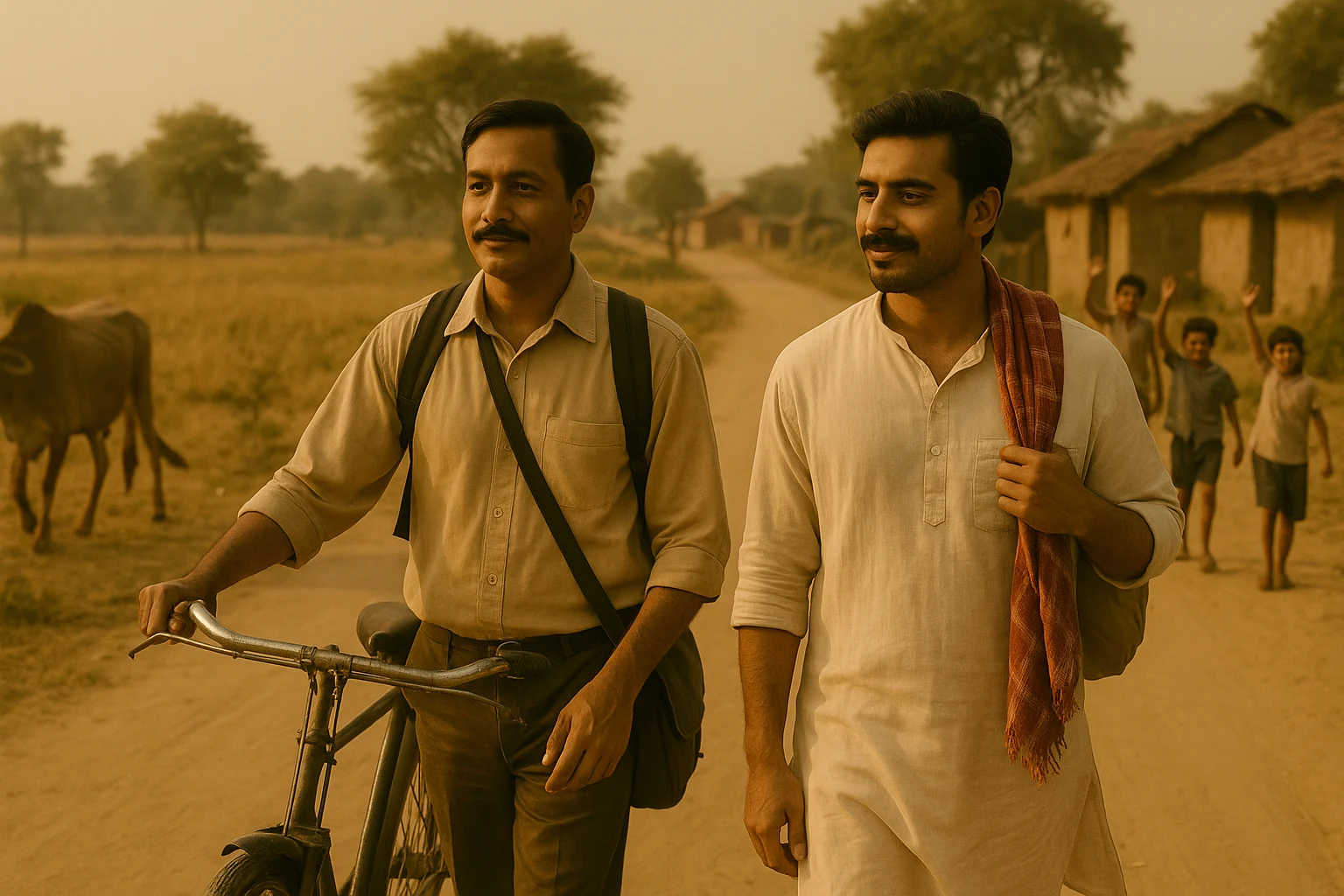Introduction
Hinduism, one of the world’s oldest living religions, is not bound by a single founder, scripture, or rigid dogma. Instead, it thrives on a complex yet harmonious interplay of philosophies, practices, and spiritual insights. Among the many profound ideas within Hindu thought, Dharma holds a central and timeless place. Dharma is not easily translatable into a single English word; terms such as “duty,” “righteousness,” “law,” “ethics,” or “cosmic order” capture parts of its essence but never the whole.
Dharma represents a universal principle that sustains the cosmos, society, and individual life. It is at once metaphysical and practical, guiding both cosmic harmony and personal conduct. This article explores Dharma in its many dimensions—its meaning in ancient scriptures, role in daily life, philosophical interpretations, and relevance in today’s world.
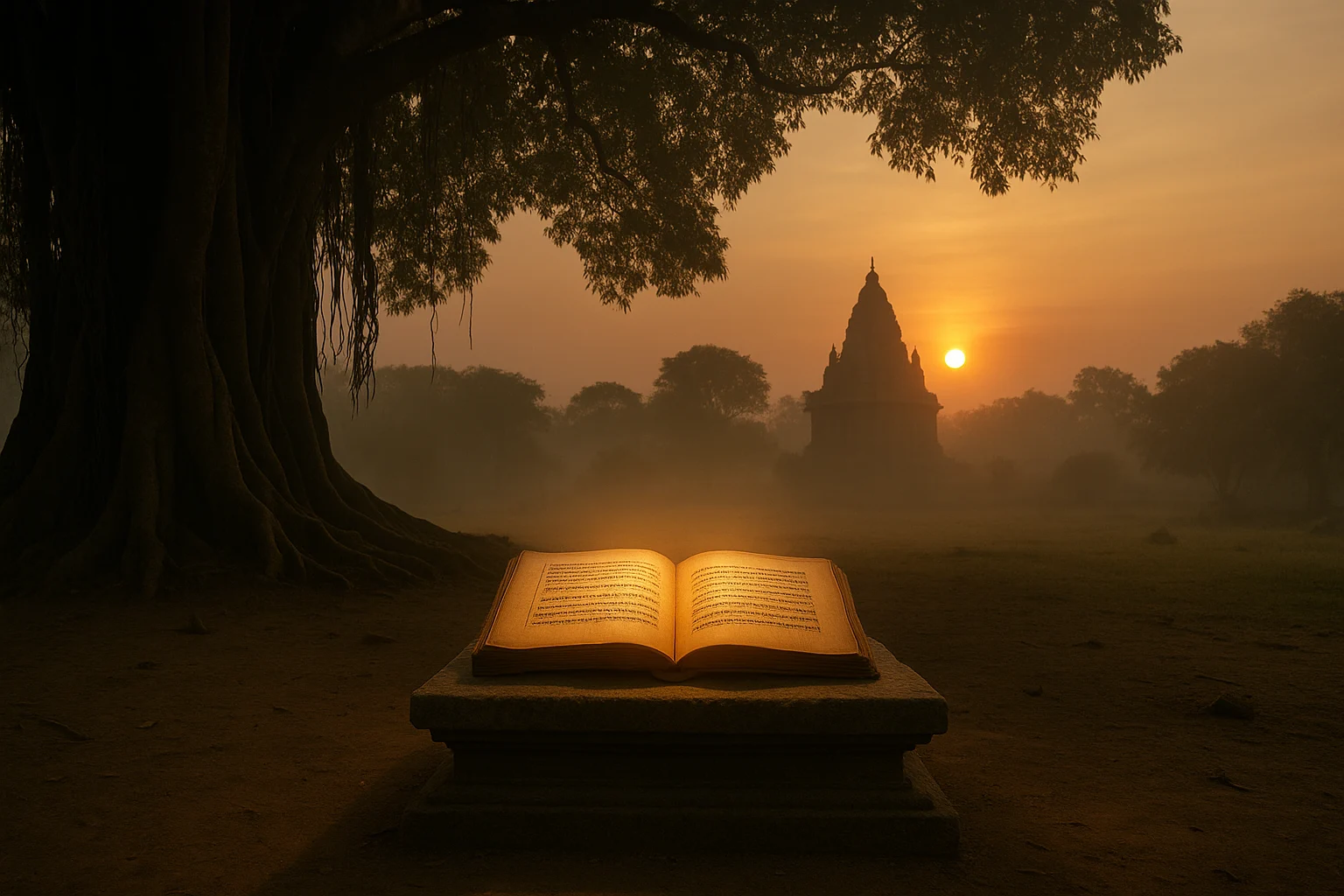
Etymology and Meaning of Dharma
The word Dharma is derived from the Sanskrit root dhṛ, meaning to hold, sustain, or support. Thus, Dharma is that which sustains the order of the universe and maintains balance in society and personal life.
In the Rigveda, Dharma is subtly referred to as the principle that sustains cosmic order (ṛta). In later texts like the Upanishads, Mahabharata, and Dharmashastras, Dharma is elaborated as ethical conduct, duties according to one’s role in society, and the path that leads to truth.
Dharma, therefore, is not just law in a legal sense but a spiritual and moral compass guiding human existence.

Dharma in Hindu Scriptures
1. The Vedas
The earliest layers of Hindu thought in the Rigveda and Atharvaveda hint at Dharma through the concept of ṛta—the cosmic order. Ṛta represents the foundation upon which gods, humans, and nature function in harmony.
2. The Upanishads
The Upanishads shift the focus from ritual to philosophy. Here, Dharma evolves into a principle of truth, knowledge, and righteous living. It becomes less about external ritual obligations and more about inner moral and spiritual responsibility.
3. The Epics – Ramayana and Mahabharata
The epics embody Dharma through lived narratives.
- In the Ramayana, Lord Rama is seen as the Maryada Purushottama (the ideal man) who upholds Dharma even at personal cost, symbolizing the primacy of duty over desire.
- In the Mahabharata, Dharma becomes more complex. The dilemmas faced by Yudhishthira, Arjuna, and others show that Dharma is not always black-and-white but situational and contextual. Lord Krishna’s teachings in the Bhagavad Gita elevate Dharma to the highest spiritual duty: selfless action aligned with divine will.
4. Dharmashastras and Smritis
Texts like Manusmriti and Yajnavalkya Smriti attempt to codify Dharma into social law, outlining duties for individuals according to their role in society, age, and stage of life. Though sometimes controversial today, these works reflect historical attempts to institutionalize Dharma.
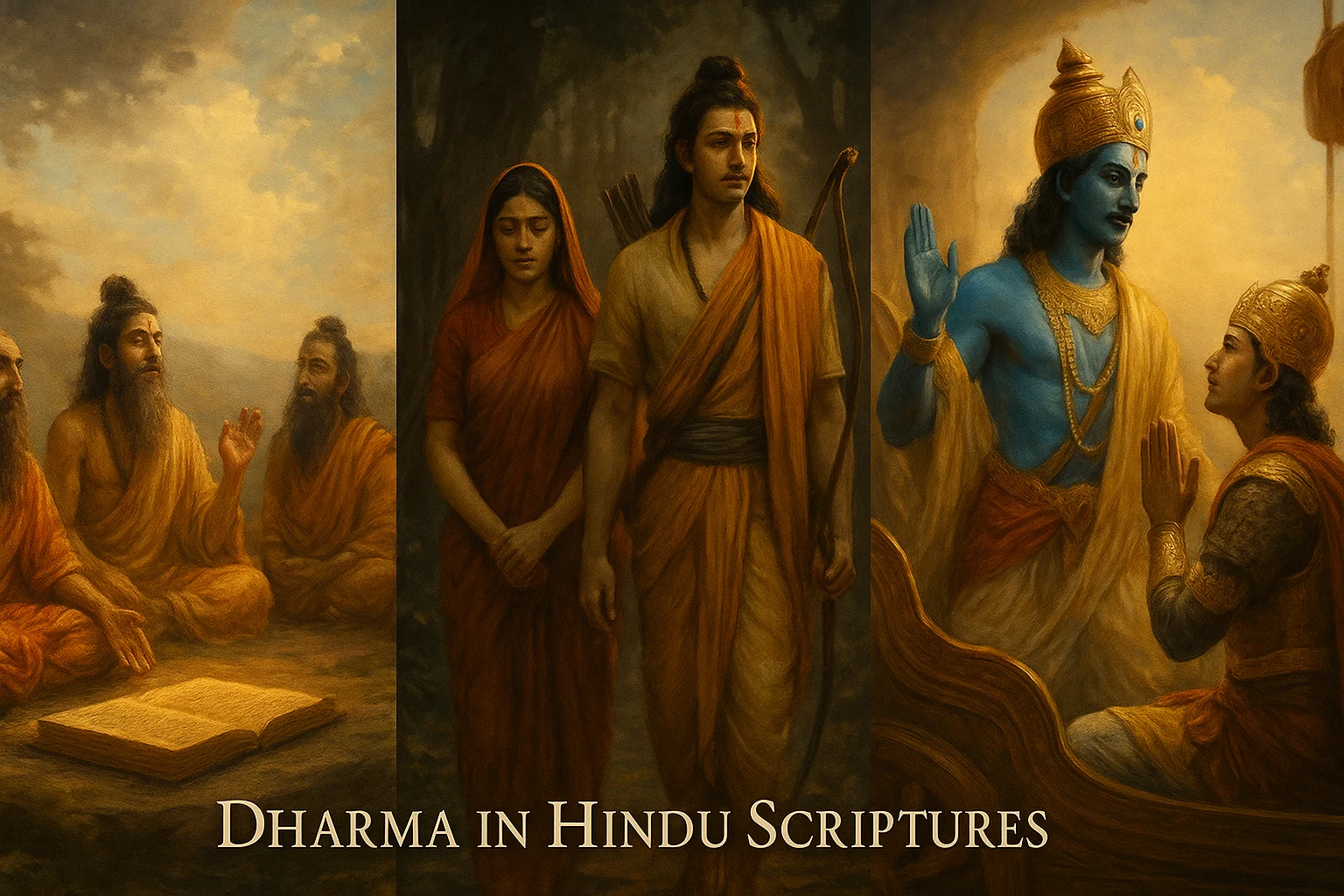
The Four Purusharthas and Dharma
Hindu philosophy identifies four aims of human life, known as the Purusharthas:
- Dharma – Righteousness, duty, moral living
- Artha – Wealth, material prosperity
- Kama – Desire, pleasure, emotional fulfillment
- Moksha – Liberation, spiritual freedom
Among these, Dharma is the foundation. Without Dharma, the pursuit of wealth and pleasure leads to chaos, and liberation becomes unattainable. Dharma ensures balance and ethical grounding in worldly pursuits.
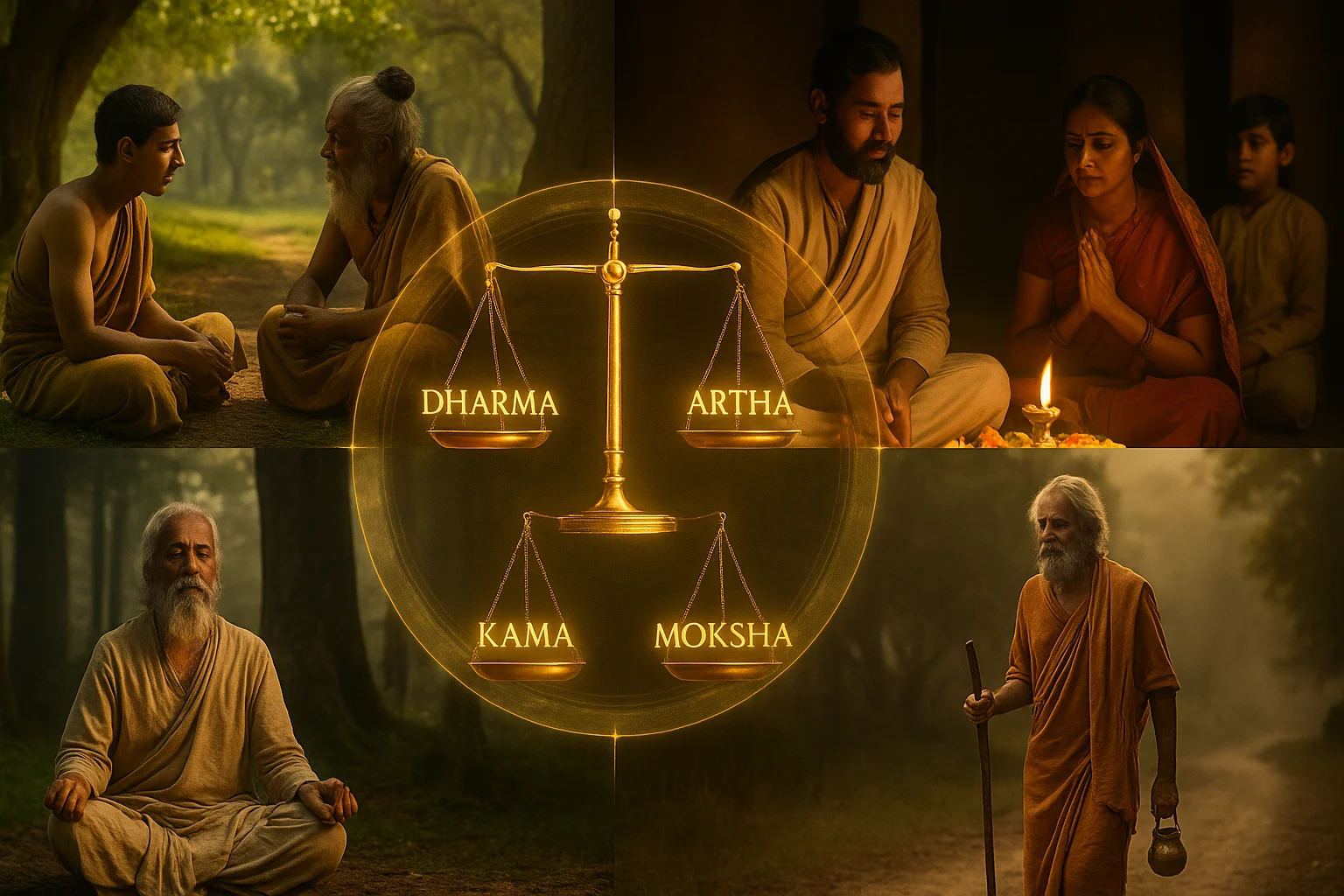
The Four Stages of Life (Ashramas) and Dharma
Hinduism divides human life into four stages (Ashramas), each with its own Dharma:
- Brahmacharya (Student life): Duty of learning, discipline, celibacy, and preparation.
- Grihastha (Householder life): Duty of raising a family, earning livelihood, practicing hospitality, and supporting society.
- Vanaprastha (Retired life): Duty of detachment, mentorship, and spiritual reflection.
- Sannyasa (Renounced life): Duty of renunciation, self-realization, and complete devotion to God.
Through these stages, Dharma evolves with age, balancing personal growth and social responsibility.
Types of Dharma
1. Sanatana Dharma (Eternal Dharma):
The universal, timeless principles of truth, non-violence, compassion, and honesty that apply to all humans regardless of caste, creed, or era.
2. Varnashrama Dharma (Social Duty):
Duties based on social role (varna) and stage of life (ashrama). For example, a teacher’s Dharma differs from that of a warrior or merchant.
3. Svadharma (Personal Duty):
The duty unique to an individual, as explained in the Bhagavad Gita. Arjuna’s duty as a warrior, even against his relatives, is his svadharma.
4. Apad Dharma (Duty in Crisis):
Dharma in emergencies, where regular duties may be suspended for higher moral reasons.
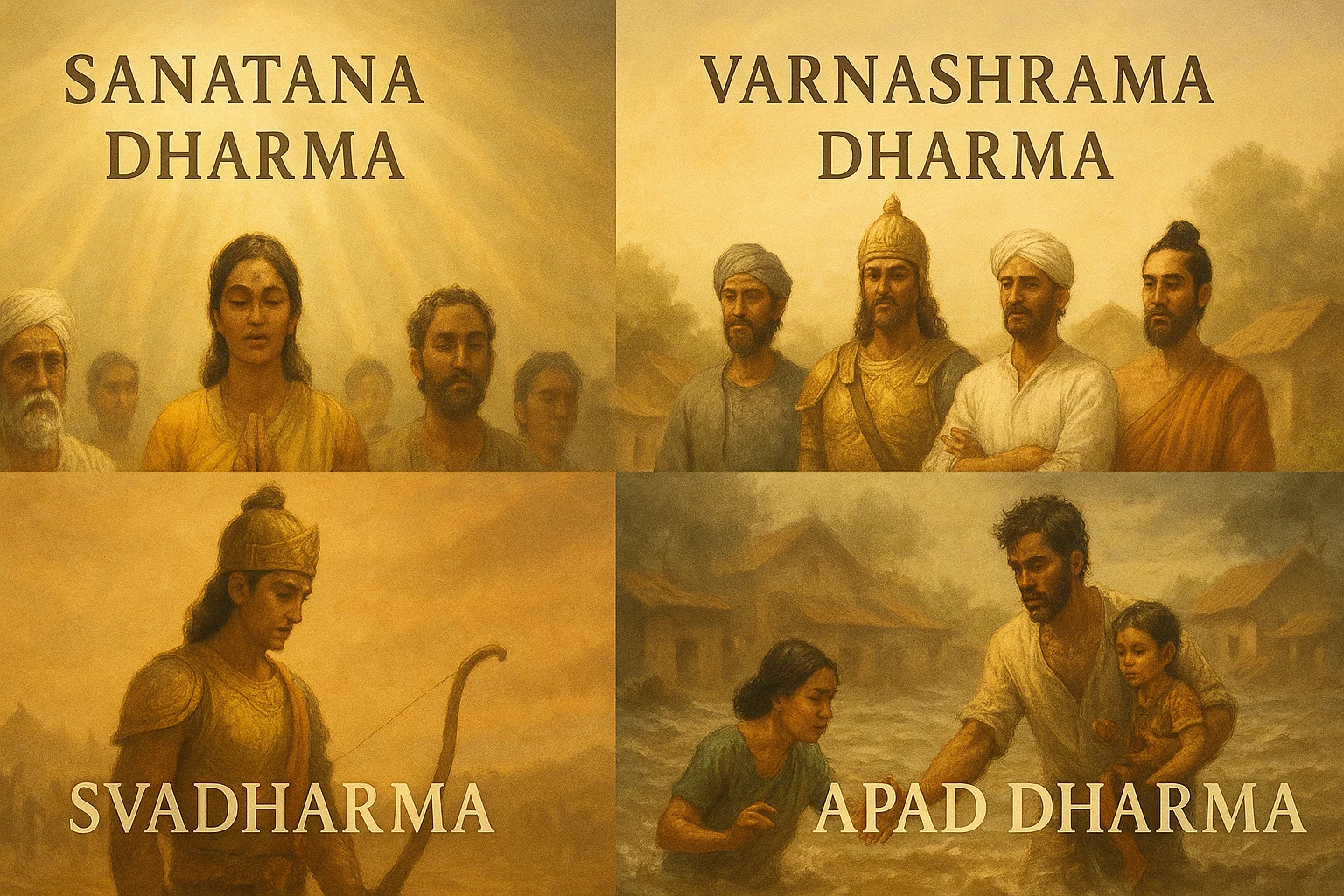
Dharma in the Bhagavad Gita
The Bhagavad Gita remains the most influential text on Dharma. When Arjuna hesitates to fight his kin in the Kurukshetra war, Krishna explains that performing one’s svadharma without attachment to results is the highest form of Dharma. This teaching harmonizes ethics with spirituality, making Dharma both a personal duty and a universal truth.
Krishna’s message highlights:
- Selfless Action (Nishkama Karma) as Dharma.
- Detachment from Results while performing duty.
- Alignment with Cosmic Order as the ultimate Dharma.

Dharma in Philosophy and Schools of Thought
Vedanta
Dharma is the means to Moksha. While rituals have limited scope, Dharma guides moral living that purifies the mind for self-realization.
Nyaya and Vaisheshika
Dharma is seen as law and ethics that ensure order in society.
Mimamsa
Emphasizes Vedic rituals as Dharma, binding human actions with divine cosmic order.
Dharma in Daily Life
For Hindus, Dharma is not abstract philosophy but practical living. It governs:
- Family duties (honoring parents, raising children)
- Social duties (honesty, fairness in work, generosity)
- Environmental duties (reverence for nature, animals, rivers, forests)
- Spiritual duties (prayer, meditation, pursuit of truth)
Thus, Dharma integrates religion, ethics, and lifestyle into one cohesive path.
Dharma and Karma
Dharma is deeply connected with Karma (action). Performing Dharma creates good Karma, leading to harmony and spiritual progress. Ignoring Dharma generates bad Karma, leading to suffering and rebirth.
This link explains why Dharma is central in Hindu thought—it influences not only this life but future lives.
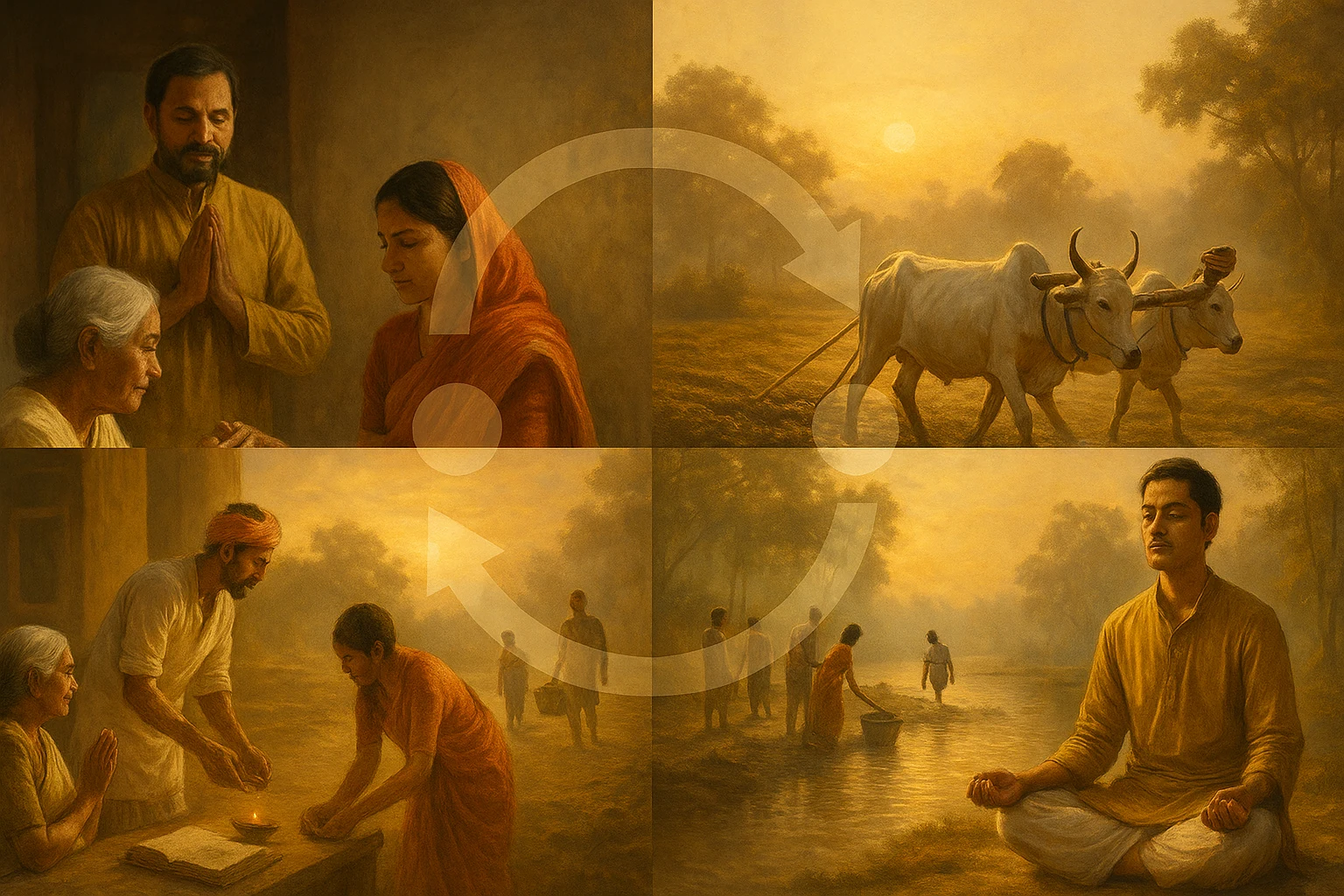
Dharma in Modern Context
Although Dharma originates in ancient texts, its relevance today is profound. In the 21st century, Dharma can be reinterpreted as:
- Personal Ethics: Living with integrity, compassion, and truthfulness.
- Social Responsibility: Contributing to society, protecting the environment, and supporting justice.
- Professional Dharma: Honesty in business, dedication in work, and fairness in leadership.
- Global Dharma: Promoting peace, sustainability, and coexistence beyond narrow identities.
Challenges and Misinterpretations of Dharma
Over time, rigid interpretations of Dharma led to caste-based discrimination and social injustice. However, reformers like Swami Vivekananda, Mahatma Gandhi, and Sri Aurobindo emphasized Sanatana Dharma—the eternal values of truth, compassion, and equality—over restrictive codes.
The challenge today lies in applying Dharma dynamically—upholding eternal values while adapting duties to contemporary realities.

Conclusion
Dharma in Hinduism is not a static law but a living principle. It is the glue that binds cosmic order, social harmony, and individual purpose. It evolves with time and context yet remains anchored in eternal truth.
From Vedic hymns to the Bhagavad Gita, from epics to modern life, Dharma inspires Hindus to live meaningfully, harmoniously, and spiritually. It teaches that the highest Dharma is not merely external duty but selfless action guided by compassion, wisdom, and truth.
In a rapidly changing world, rediscovering Dharma is not only essential for Hindus but also a universal lesson for humanity.
Receive Stories and Articles in your Inbox!
We won’t send any promotional or spam emails.






















